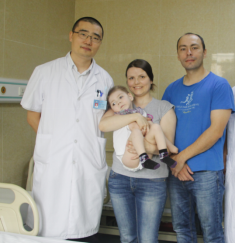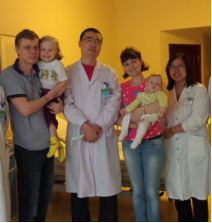Nationality: Lulu
Age: 7 years old
Diagnosis: Cerebral Palsy
First Admission Date: Dec 2010 (First Course of Treatment)
Second Admission Date: Mar 2012 (Second Course of Treatment)

Lulu, born preterm with a low birth weight of 1.5 kg, developed spastic cerebral palsy due to postnatal hypoxia. A brain MRI conducted at the Affiliated Hospital of Inner Mongolia Medical University on February 4, 2010, revealed two critical findings:
1. Bilateral malacia foci in the lateral ventricles and centrum semiovale.
2. Hypoplasia of the corpus callosum** (developmental abnormality of the brain’s connective structure).
In December 2010, Lulu underwent her first round of stem cell transplantation, which yielded promising clinical improvements. A second round of stem cell therapy was administered in March 2012 to further consolidate her progress.
Notably, Lulu’s journey was documented in a short film featured on CCTV’s popular science program "Approaching Science". The episode, highlighting her medical breakthroughs and resilience, has been broadcast globally, raising awareness about innovative therapies for cerebral palsy.
• She was able to stand upright independently for approximately 10 minutes, yet the muscle strength in her waist was feeble, and she could only stand independently with her hips elevated.
• She could walk unsteadily on her own for around 10 steps.
• She was unable to squat down and then stand up without assistance.
• When seated on a stool, she could not rise to a standing position by herself.
• Her hand - rotation movements were clumsy bilaterally.
• The flexibility of her left hand was poor, particularly when stretching or making a two - finger pointing gesture with her left hand.
First Course of Stem Cell Treatment (August 2017)
Treatment Methods: lumbar puncture and stereotactic brain surgery
• She as able to stand upright independently for approximately 10 minutes, yet the muscle strength in her waist was feeble, and she could only stand independently with her hips elevated.
• She could walk unsteadily on her own for around 10 steps.
• She was unable to squat down and then stand up without assistance.
• When seated on a stool, she could not rise to a standing position by herself.
• Her hand - rotation movements were clumsy bilaterally.
• The flexibility of her left hand was poor, particularly when stretching or making a two - finger pointing gesture with her left hand.
Her left hand shows greater flexibility, especially when she stretches her fingers or makes a two - finger pointing gesture.
Outcomes After the Second Course of Treatment
• Her waist muscle strength has improved significantly. Now, she can stand on her own steadily, no longer needing to stand with her hips raised to maintain balance.
• She is capable of walking steadily on her own for several hundred meters.
• Squatting down and then standing up has become an easy task for her, which she can do with ease.
• When seated on a stool, she can effortlessly rise to a standing position by herself.
• The flexibility of her hands has been remarkably enhanced. Hand rotation movements are much more fluid.
• Her left hand shows greater flexibility, especially when she stretches her fingers or makes a two - finger pointing gesture.
Progress Summary & Future Outlook
Given the remarkable progress Lulu has achieved to date, it is highly anticipated that her physical functions will continue to improve. With consistent rehabilitation and targeted training, she is likely to experience further enhancements in muscle strength, balance, and coordination. In the near future, she may be capable of undertaking more physically demanding activities, significantly expanding her range of daily and recreational pursuits.
Regular follow - up assessments and personalized exercise regimens will play a crucial role in maintaining and accelerating these positive changes. This comprehensive approach not only ensures the consolidation of her current gains but also paves the way for her to reach new heights in physical recovery and overall well-being.



